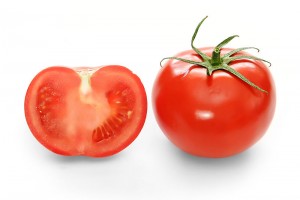Tomato
2012

Tomatoes are well known for their antioxidant lycopene, but they contain so many more antioxidant substances and their broad range of beneficial phytonutrients are off the chart.
About – The Tomato is botanically not only considered a fruit, but technically a berry, since it is formed from a single ovary. But for culinary purposes is referred to as a vegetable. The French sometimes refer to the tomato as ‘pomme d’amour’ or love apple. The tomato is a popular and versatile food that comes in over a thousand different varieties that vary in shape, size, and color. Tomatoes have fleshy internal segments filled with slippery seeds surrounded by a watery matrix. It is an annual in its native habitat but often grown outdoors as an annual in temperate climates. Tomatoes can be red, pink, yellow, orange/tangerine, green, purple, brown, or black in color. They vary greatly in size with beefsteak being the largest, Roma are medium sized and cherry or grape tomatoes the smallest. The tomato was first cultivated in Mexico, then brought to Europe in the 1500’s and today is enjoyed worldwide. It is one of the most popular vegetables worldwide with 130 million tons produced each year.
Nutrition – Tomatoes are abundant in nutrients and especially in antioxidants. They have high levels of vitamins C and E, powerful antioxidants, as well as vitamins A (beta carotene), K and lots of B’s, including thiamin (B1), niacin (B3), B6 and folic acid (B9). They are mineral rich with heart-healthy magnesium, potassium, phosphorus, copper and blood sugar-balancing manganese.
The nutrition in tomatoes is often associated with lycopene, a carotenoid phytonutrient with strong antioxidant properties and which gives tomatoes their deep red color. However, tomatoes provide a unique variety of other phytonutrients, including other carotenoids (beta-carotene, lutein, and zeaxanthin), flavonoids (naringenin, chalconaringenin, rutin, kaempferol, and quercetin), hydroxycinnamic acids (caffeic, ferulic, and coumaric acid), glycosides (esculeoside A) and fatty acid derivatives (9-oxo-octadecadienoic acid). Tomatoes has long been linked to heart health. They have been shown to help lower cholesterol and to help prevent clumping together of platelet cells in the blood.







